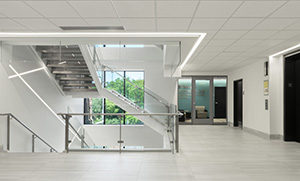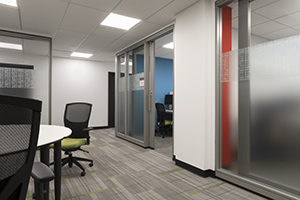Smart Design Principles Boost Productivity & Sustainability
By Denny Crain
As times and technology change so do student’s needs. When faced with rising financial pressures and students changing preferences, colleges and universities continue to look for new ways to reduce operating costs while continuing to improve the educational experience. To do so, architects and designers face these design challenges head on, ultimately creating new trends and principles for sustainable institutions.

Smart design practices can create visually impactful spaces that are both functional and efficient for student and staff use while improving the sustainability of a project. Any academic building can benefit from these design principles that are specifically applied to enhance the productivity of students and staff and conservation of resources. Productive environments can be achieved sustainably by reducing the footprint of the building using space-utilization strategies, using sustainable materials that are long-lasting and flexible for future use, and installing energy-efficient lighting and utility alternatives.
Productivity
Productivity to a university and building management team is synonymous with a quantifiable output, result or rate of efficiency. For almost any institution, the motivation behind increasing the rate of productivity is to positively affect its bottom line and the student’s performance and satisfaction. The design of a space can impact the user’s health, wellness and comfort and ultimately their productivity. Improving the ergonomics of a workspace, controlling the air temperature and the level of natural light are just some of the ways in which universities can satisfy a student’s comfort level. By implementing a variety of design principles to address factors in the physical environment, institutions can increase the overall productivity of not only the students and staff, but also the building as a whole.
Design Trends
An important consideration when implementing a sustainable, productive design in a school setting is the trends that are important to students and staff. A new generation of students, raised on smartphones and tablets, have different styles of working and preferences than the generations of students who came before them. How these students

Photo Credit (all): Remiger Design
experience the world around them is pushing the boundaries of design for school campuses across the country. In order to keep this new generation of students productive, architects and designers need to address the different ways in which they work and learn, as well as their different mindsets and thought processes regarding school space.
In recent years, schools and universities have been implementing more flexible spaces that can be used either for quiet individual studying or collaborative group projects. This gives students the chance to personalize their space in unique and productive ways depending on the occasion. The aim of this design trend is to provide a balance between public spaces, private, semi-private and public areas to work. Adding furniture systems that can be adapted and adjusted for different users and scenarios will ultimately provide a long-term sustainable solution as design trends continue to evolve.
Read the entire article by Denny Crain in the July/August issue of School Construction News. Crain is a registered architect at Remiger Design, a St. Louis-based planning, architecture and interior design firm specializing in the planning and design of commercial and corporate facilities.

